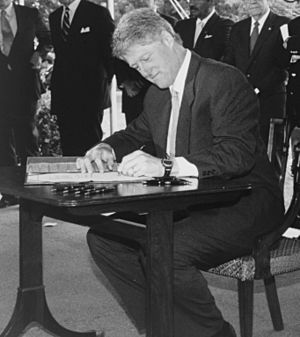National Voter Registration Act of 1993 facts for kids
 |
|
| Long title | An Act to establish national voter registration procedures for Federal elections, and for other purposes. |
|---|---|
| Acronyms (colloquial) | NVRA |
| Nicknames | National Voter Registration Act, Motor Voter |
| Enacted by | the 103rd United States Congress |
| Effective | January 1, 1995 |
| Citations | |
| Public law | 103-31 |
| Statutes at Large | 107 Stat. 77 |
| Codification | |
| Titles amended | 42 U.S.C.: Public Health and Social Welfare transferred to 52 U.S.C.: Voting and Elections |
| U.S.C. sections created | 42 U.S.C. ch. 20, subch. I-H § 1973gg et seq. transferred to 52 U.S.C. §§ 20501–20511 |
| Legislative history | |
|
|
| United States Supreme Court cases | |
|
|

The National Voter Registration Act of 1993 (NVRA) is also known as the Motor Voter Act. It is a United States federal law that President Bill Clinton signed on May 20, 1993. The law officially started on January 1, 1995.
This law helps make it easier for people to vote in the United States. It requires state governments to offer simple ways for eligible people to register to vote. This happens when they apply for or renew a driver's license. It also happens when they apply for certain public help programs. The law also says that states must accept a special federal voter registration form. It also stops states from removing registered voters from their lists unless specific rules are followed.
Some states do not have to follow all parts of this law. These are states that have not required voter registration for federal elections since August 1, 1994. Or, they have allowed people to register and vote on the same day (called Election Day Registration or EDR). Six states are exempt: North Dakota, Idaho, Minnesota, New Hampshire, Wisconsin, and Wyoming.
Contents
Why Was This Law Needed?
Making Voting Easier for Everyone
After the Voting Rights Act of 1965 helped stop unfair voting practices, people still wanted to make voting even easier. In the 1970s, there were ideas to send voter registration forms to every home. But these ideas did not become laws. Later, proposals to let people register at public offices or on Election Day also failed.
Helping Specific Groups Vote
In the 1980s, Congress passed two laws to help certain groups vote. The Voting Accessibility for the Elderly and Handicapped Act of 1984 made sure older and disabled voters had easy ways to register. The Uniformed and Overseas Citizens Absentee Voting Act of 1986 helped military members and citizens living abroad register by mail.
The "Motor Voter" Idea
In the late 1980s and early 1990s, many people were not voting in federal elections. So, Congress started looking at ways to make voter registration easier for everyone. They came up with "motor voter" bills. These bills would require state motor vehicle offices to offer voter registration when people got their driver's licenses.
The first "motor voter" bill passed in the House of Representatives in 1989 but failed in the Senate. A similar bill in 1991 passed both the Senate and House. But President George H. W. Bush did not sign it into law. Two years later, Congress passed almost the same bill. This became the National Voter Registration Act of 1993.
What the Law Covers and Who is Exempt
Federal and State Elections
The National Voter Registration Act officially applies only to federal elections. However, most states use the same system for both federal and state elections. This means the rules of the NVRA usually apply to state elections too.
States That Don't Need to Follow All Rules
As mentioned, some states do not have to follow all parts of the NVRA. These are states that have always, since August 1, 1994, either:
- Not required voter registration for federal elections at all.
- Allowed people to register and vote on the same day (Election Day Registration or EDR).
Currently, six states are exempt: North Dakota (which does not require registration), and Idaho, Minnesota, New Hampshire, Wisconsin, and Wyoming (because they have EDR).
Key Parts of the National Voter Registration Act
Using a Federal Voter Registration Form
The NVRA requires states to accept and use a special federal form to register voters. This form is called the National Mail Voter Registration Form. It was first created by the Federal Election Commission (FEC). Now, the Election Assistance Commission (EAC) is in charge of it. People can use this federal form instead of a state's own form. On the federal form, applicants must state they are a citizen, under penalty of perjury.
For a while, Arizona required people to show proof of citizenship, like a birth certificate, even with the federal form. But in 2013, the Supreme Court of the United States said Arizona could not do this. The Court ruled that the NVRA means states must accept the federal form as it is.
Registering When You Get a Driver's License
One of the most important parts of the law is called Section 5. It requires state motor vehicle offices to offer voter registration. They must do this when someone applies for a new driver's license or state ID card. They also offer it when someone renews their license or ID. The state then sends the completed registration form to the right election office.
This is why the law is often called the "Motor Voter Act." It makes it easy to register to vote while doing something else you already need to do.
Registering at Public Assistance Offices
Section 7 of the Act says that state offices that provide public help must also offer voter registration. This includes offices that help with programs like food stamps, Medicaid, and WIC. When people apply for these services, renew them, or change their address, they must be offered a voter registration form. They should also get help filling out the form. The office then sends the form to the correct election official.
The Federal Voting Assistance Program (FVAP) helps U.S. citizens living abroad register to vote. They also allow eligible citizens to register at military recruitment offices.
Registering by Mail
Section 6 of the Act allows people to send in their voter registration forms by mail. States and the Election Assistance Commission create special mail-in forms for this purpose.
There was a case in Georgia where a group tried to register voters. The state rejected their forms because they were submitted in a bundle. A federal court later ruled that private groups have the right to help people register to vote by mail. This is allowed under the National Voter Registration Act.
Keeping Voter Lists Up-to-Date
Section 8 of the Act explains how states should keep their voter registration lists accurate. States need to identify people who are no longer eligible to vote. This might be because they have passed away or moved out of the area.
However, the law also has rules to protect voters. States cannot remove voters from lists just because they haven't voted in a while. They also cannot remove voters within 90 days of a federal election. If a voter moves within the same district, they can still vote even if they haven't re-registered their new address.
How the Law Has Helped
Organizations that work for voting rights say that the NVRA has helped many people register to vote. They also work to make sure states follow the law correctly. Groups like Demos and the Campaign Legal Center have filed lawsuits to ensure states make it easy for people to register and vote. These efforts have led to positive changes in how some states handle voter registration.

